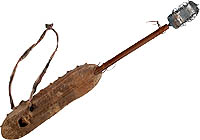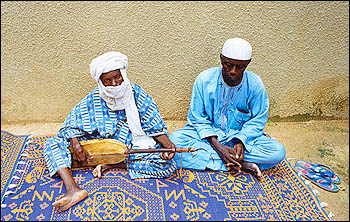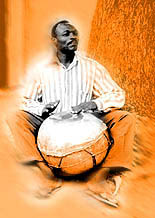|
|
|
Jeli-koni
Mali
Ethnic group: Bamanan
Made by Jeli Oumar, known as Maa Ncinii Konè, a griot
Sound box made by Jeli Oumar's father, Cuanta Koumaré, a blacksmith
2000
Canadian Museum of Civilization
|
|

|



J eli-koni literally means "griot's lute". In many
African societies, the majority of the population consists of farmers, and the rest is
made up of artisan blacksmiths, woodworkers, shoemakers and musicians. The members of
the musicians' caste — artisans who have certain privileges and are forbidden to do
certain things — are called griots. They are the artisans of language — the guardians
of tradition — and their knowledge includes genealogy, tales, epics and songs
To become a griot, one must know how to manipulate language. Mastery of language and
memory training are among the subjects taught at the "school of the spoken word",
whereby griots transmit their knowledge to a member of their family or their caste. A griot
must possess two qualities: imagination and heart. To clearly express what it is possible to
achieve with these qualities, three factors must come into play: spirit, intelligence
and memory.

In the past, the koni was played at the royal court to entertain the king of
Ségou, the former capital of Mali, by evoking his power, victories and qualities
as a warrior. Today, this four-stringed lute is used only on happy occasions, such as
baptisms, weddings and circumcisions. The music of the koni awakens one's
sensibility by increasing happiness, which may reach the level of ecstasy. It incites
people to surpass themselves, to the point of putting their lives in danger. The
koni accompanies stories that focus on the life of heroes. These stories now
constitute the bulk of the instrument's repertoire and are told by musicians during
nocturnal gatherings.
|



